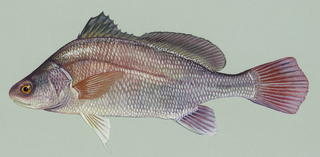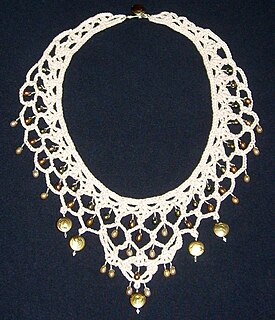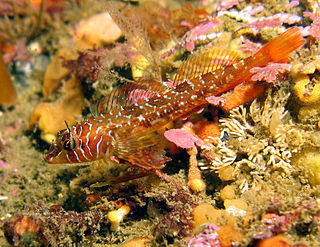
A pearl is a hard glistening object produced within the soft tissue of a living shelled mollusk or another animal, such as a conulariid. Just like the shell of a mollusk, a pearl is composed of calcium carbonate in minute crystalline form, which has been deposited in concentric layers. The ideal pearl is perfectly round and smooth, but many other shapes, known as baroque pearls, can occur. The finest quality natural pearls have been highly valued as gemstones and objects of beauty for many centuries. Because of this, pearl has become a metaphor for something rare, fine, admirable and valuable.

Mussel is the common name used for members of several families of bivalve molluscs, from saltwater and freshwater habitats. These groups have in common a shell whose outline is elongated and asymmetrical compared with other edible clams, which are often more or less rounded or oval.

The zebra mussel is a small freshwater mussel. This species was originally native to the lakes of southern Russia and Ukraine. However, the zebra mussel has been accidentally introduced to numerous other areas, and has become an invasive species in many countries worldwide. Since the 1980s, they have invaded the Great Lakes and the Hudson River.

The freshwater drum, Aplodinotus grunniens, is a fish endemic to North and Central America. It is the only species in the genus Aplodinotus. The freshwater drum is a member of the family Sciaenidae, and is the only North American member of the group that inhabits freshwater for its entire life. Its generic name, Aplodinotus, comes from Greek meaning "single back", and the specific epithet, grunniens, comes from a Latin word meaning "grunting". It is given to it because of the grunting noise that mature males make. This noise comes from a special set of muscles within the body cavity that vibrate against the swim bladder. The purpose of the grunting is unknown, but due to it being present in only mature males, it is assumed to be linked to spawning.

The New Zealand freshwater mussel, also known by its Māori names kākahi, kāeo, and torewai, is a species of freshwater mussel endemic to New Zealand. E. menziesii is an aquatic bivalve mollusc in the family Unionidae, the river mussels.

The freshwater pearl mussel is an endangered species of freshwater mussel, an aquatic bivalve mollusc in the family Margaritiferidae.

Margaritiferidae is a family of medium-sized freshwater mussels, aquatic bivalve molluscs in the order Unionida. They are known as freshwater pearl mussels, because the interior of the shell of these species has a thick layer of nacre or mother of pearl, and the mussels are thus capable of producing pearls.

Margaritifera is a genus of freshwater mussels, aquatic bivalve molluscs in the family Margaritiferidae, the freshwater pearl mussels.

Cultured freshwater pearls are pearls that are farmed and created using freshwater mussels. These pearls are produced in Japan and the United States on a limited scale, but are now almost exclusively produced in China. The U.S. Federal Trade Commission requires that farmed freshwater pearls be referred to as "freshwater cultured pearls" in commerce. Quality of cultured freshwater pearls is evaluated through a grading system of a series of A values, based on luster, shape, surface, color, and matching.
Pleurobema furvum, the dark pigtoe, is a species of freshwater mussel in the family Unionidae, the river mussels. This aquatic bivalve mollusk is native to Alabama in the United States, where it is mainly limited to the Black Warrior River. It is a federally listed endangered species of the United States.

Potamilus capax, the fat pocketbook pearly mussel or fat pocketbook, is a species of freshwater mussel, an aquatic bivalve mollusk in the family Unionidae, the river mussels.
Freshwater bivalves are one kind of freshwater molluscs, along with freshwater snails. They are bivalves which live in freshwater, as opposed to saltwater, the main habitat type for bivalves.

The glochidium is a microscopic larval stage of some freshwater mussels, aquatic bivalve mollusks in the families Unionidae and Margaritiferidae, the river mussels and European freshwater pearl mussels.

Velesunio ambiguous, the flood plain mussel, is a species of freshwater bivalve in the family Hyriidae.

Freshwater molluscs are those members of the Phylum Mollusca which live in freshwater habitats, both lotic such as rivers, streams, canals, springs, and cave streams and lentic such as lakes, ponds, and ditches.

South Africa has an emerging aquaculture. It consists mainly of culture of freshwater species such as crocodiles, trout, catfish, tilapia and ornamental fish as well as marine species such as abalone, prawns, oysters and mussels.














